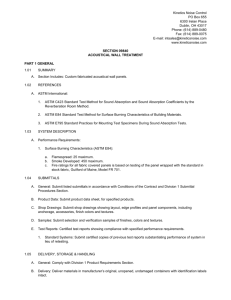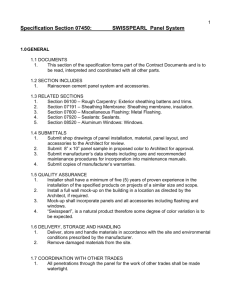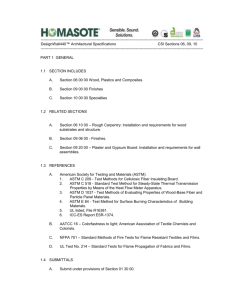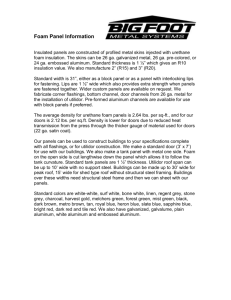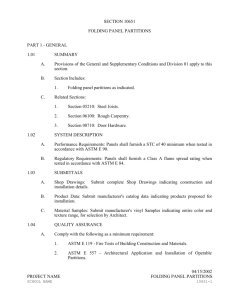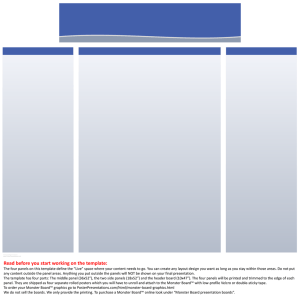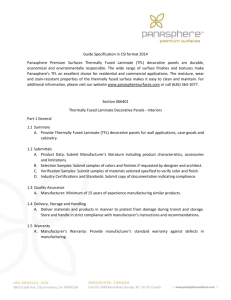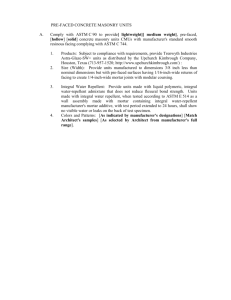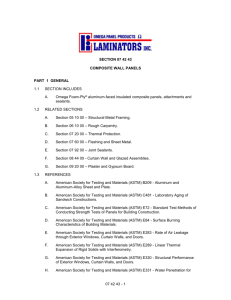FAX - Keith Panel Systems
advertisement
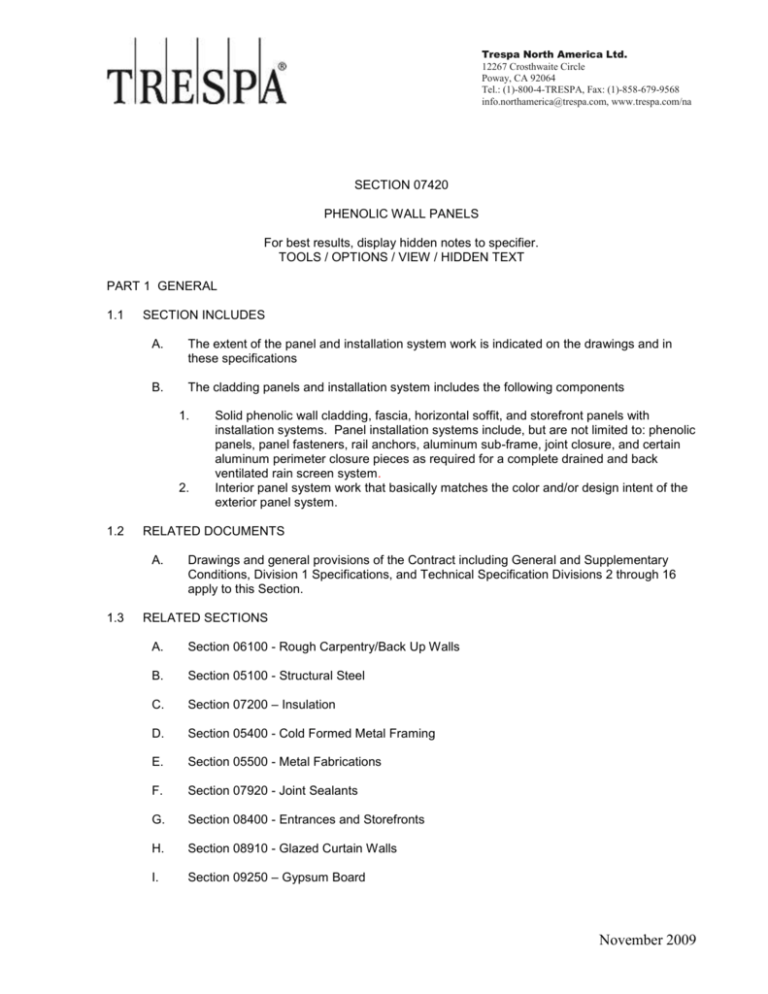
Trespa North America Ltd. 12267 Crosthwaite Circle Poway, CA 92064 Tel.: (1)-800-4-TRESPA, Fax: (1)-858-679-9568 info.northamerica@trespa.com, www.trespa.com/na SECTION 07420 PHENOLIC WALL PANELS For best results, display hidden notes to specifier. TOOLS / OPTIONS / VIEW / HIDDEN TEXT PART 1 GENERAL 1.1 SECTION INCLUDES A. The extent of the panel and installation system work is indicated on the drawings and in these specifications B. The cladding panels and installation system includes the following components 1. 2. 1.2 RELATED DOCUMENTS A. 1.3 Solid phenolic wall cladding, fascia, horizontal soffit, and storefront panels with installation systems. Panel installation systems include, but are not limited to: phenolic panels, panel fasteners, rail anchors, aluminum sub-frame, joint closure, and certain aluminum perimeter closure pieces as required for a complete drained and back ventilated rain screen system. Interior panel system work that basically matches the color and/or design intent of the exterior panel system. Drawings and general provisions of the Contract including General and Supplementary Conditions, Division 1 Specifications, and Technical Specification Divisions 2 through 16 apply to this Section. RELATED SECTIONS A. Section 06100 - Rough Carpentry/Back Up Walls B. Section 05100 - Structural Steel C. Section 07200 – Insulation D. Section 05400 - Cold Formed Metal Framing E. Section 05500 - Metal Fabrications F. Section 07920 - Joint Sealants G. Section 08400 - Entrances and Storefronts H. Section 08910 - Glazed Curtain Walls I. Section 09250 – Gypsum Board November 2009 J. 1.4 Section 09200 – Interior Wall Finishes REFERENCES A. ISO 178 – Determination of Flexural Properties B. ISO 527-3 – Determination of Tensile Properties C. EN 438-2 – Decorative High Pressure Laminate (HPL) Sheets Based on Thermosetting Resins – Determination of Properties D. EN 12524 – Building Materials and Products, Hygrothermal Properties, Tabulated Design Values E. ASTM E330 – Standard Test Method for Structural Performance of Exterior Windows, Curtain Walls, and Doors Under the Influence of Wind Loads F. ASTM E 84 - Standard Test Method for Surface Burning Characteristics of Building Materials G. ASTM D1929 – Standard Test Method for Ignition Temperature H. ASTM D635 – Standard Test Method for Small Scale Burning I. ASTM E119 – Standard Test Method for Fire Rated or Fire Resistive Construction J. NFPA 285 – Standard Fire Test Method for Evaluation of Fire Propagation Characteristics of Exterior Non-Load-Bearing Wall Assemblies Containing Combustible Components K. NFPA 268 – Standard Test Method for Determining Ignitibility of Exterior Wall Assemblies Using a Radiant Heat Energy Source L. ASTM D 2247 - Standard Practice for Testing Water Resistance of Coatings in 100% Relative Humidity M. ASTM B117 - Standard Practice for Operating Salt Spray (Fog) Apparatus N. ASTM D2244 - Standard Practice for Calculation of Color Tolerances and Color Differences from Instrumentally Measured Color Coordinates O. ISO 105 A02-93 - Tests for Color Fastness -- Part A02: Grey scale for assessing change in color P. ISO 846 – Evaluation of the Action of Organisms Q. Miami-Dade Notice of Acceptance (NOA) No. 08-0922.07 R. GREENGUARD® and GREENGUARD® Children & SchoolsTM 947-5 November 2009 1.5 SUBMITTALS A. Submit under provisions of Section 01300 B. Product Data: Manufacturer's data sheets on each product to be used, including: 1. 2. 3. Preparation instructions and recommendations Storage and handling requirements and recommendations Installation methods C. Statement certifying that the material meets the requirements specified D. Shop Drawings: Submit plan, section, elevation and perspective drawings necessary to describe and convey the layout, profiles and product components, including edge conditions, panel joints, fixture location, anchorage, accessories, finish colors, patterns and textures. E. Documents showing product compliance with local building code shall be submitted prior to the bid. These documents shall include, but not be limited to, appropriate Evaluation Reports and/or test reports supporting the use of the product. Alternate materials must be approved by the architect of record prior to the bid date. F. Engineering Calculations: Submit engineering calculations as required by the local building code, showing that the installed panels and attachments system meets the wind load requirements for the project. G. Selection Samples: For each finish product specified, two complete sets of color chips representing manufacturer's full range of available colors and patterns. Please note that samples are only representative for color and pattern and not for thickness or edge finish. Metallic colors may also show a slight fluctuation in appearance due to the metal flake orientation from batch to batch. H. Verification Samples: For each finish product specified, two samples a minimum of 3.5 inches by 3.5 inches (89mm x 89mm) representing actual product, color, and patterns. Sample edges may vary from field panel edges. I. LEED Submittals: Submit Documentation affirming the eligibility for the following credits under the following USGBC LEED NC V2.2 Standards: 1. 2. 3. 4. 5. 6. 7. Credit: MRc1.1 - Reuse of 75 percent of existing walls, floors and roof - 1 Credit Credit: MRc1.2 - Reuse of 95 percent of existing walls, floors and roof - 1 Credit Credit: MRc1.3 - Reuse of 50 percent of interior non-structural elements – 1 Credit Credit: MRc2.1 - Diversion of 50 percent of demolition from landfills - 1 Credit Credit: MRc2.2 - Diversion of 75 percent of demolition from landfills - 1 Credit Credit: MRc3.1 - Reuse of 5 percent of existing materials - 1 Credit Credit: MRc3.2 - Reuse of 10 percent of existing materials - 1 Credit November 2009 J. Closeout Submittals: 1. 1.6 QUALITY ASSURANCE A. Manufacturer Qualifications: All primary panel products specified in this section will be supplied by a single manufacturer with a minimum of ten (10) years experience. 1. Products covered under the Work listed in this section are to be manufactured in an ISO 9001 certified facility. B. Installer Qualifications: All products listed in this section are to be installed by a single installer trained and approved by the manufacture or representative. C. Mock-Up: Provide a mock-up for evaluation of the product and application workmanship. 1. D. 1.7 Operation and Maintenance Data: Submit operation, maintenance, and cleaning information for products covered under this section. Do not proceed with remaining work until workmanship, color, and sheen are approved by Architect. Pre-installation Meetings: Conduct pre-installation conference to verify project requirements, substrate conditions, manufacturer’s installation instructions and manufacturer’s warranty requirements. DELIVERY, STORAGE, AND HANDLING A. Delivery: 1. 2. B. During transportation, use stable, flat pallets that are at least the same dimension as the sheets. Materials shall be packaged to minimize or eliminate the possibility of damage during shipping. Items such as wooden side boards, wooden lid, and spacers or protective sheeting between panels shall be used to protect the panels from surface and/or edge damage. Storage: 1. 2. 3. 4. 5. Store products in an enclosed area protected from direct sunlight, moisture and heat. Maintain a consistent temperature and humidity. Store products in manufacturer's unopened packaging until ready for installation. Stack panels using protective dividers to avoid damage to decorative surface. For horizontal storage, store sheets on pallets of equal or greater size as the sheets with a protective layer between the pallet and sheet and on top of the uppermost sheet. Do not store sheets, or fabricated panels vertically. November 2009 C. Handling: 1. 2. 3. 1.8 Remove protective film within 24 hours of the panels being removed from the pallet. When moving sheets, lift evenly to avoid dragging panels across each other and scratching the decorative surface. Remove all labels and stickers immediately after installation. PROJECT CONDITIONS A. Maintain environmental conditions (temperature, humidity, and ventilation) within limits recommended by manufacturer for optimum results. Do not install products under environmental conditions outside manufacturer's absolute limits. B. Field Measurements: Verify actual measurements/openings by field measurements performed by the installer prior to release for fabrication. Recorded measurements to be indicated on shop drawings based on field measurements provided by the installer. Coordinate field measurements and fabrication schedule with construction progress to avoid construction delays. C. WARRANTY: At project closeout, provide Manufacturer’s limited ten (10) year warranty covering defects in materials. Warranty only available when material installed by an installation contractor trained and approved by the manufacturer’s representative. PART 2 PRODUCTS 2.1 2.2 MANUFACTURERS A. Acceptable Panel Manufacturer: Trespa International 12267 Crosthwaite Cir., Poway, CA 92064. ASD. Toll Free Tel: (800) 4-TRESPA. Tel: (858) 679-2090. Fax: (858) 679-9568. Email: info.northamerica@trespa.com. Web: http://www.trespa.com/na. B. Acceptable Manufacturer’s Representative: Keith Panel Systems Co. Ltd.; Tel: 604-9874499. Fax:604-987-4742. Email:mail@keithpanel.com. Web:http://www.keithpanel.com C. Substitutions: Not permitted D. Items of the same function and performance which have received prior approval from the architect shall be allowed for this project. Approval shall be based on documentation submitted showing the adequacy of the proposed material to meet the performance requirements of this specification. SCOPE / APPLICATION Plans, elevations, details, characteristics, and other requirements indicated are based upon standards by a single manufacturer. Alternate material manufacturers, receiving prior approval, may be acceptable provided their details and characteristics comply with the material/performance standards of the project. November 2009 2.3 A. TS110 – Exposed fastening on fixed depth aluminum sub-framing B. TS120 - Exposed fastening on variable depth aluminum sub-framing C. TS210 – Concealed fastening over fixed depth aluminum sub-framing D. TS220 - Concealed fastening over variable depth aluminum sub-framing E. TS110-285 - Exposed fastening on fixed depth aluminum sub-framing tested and meeting the performance requirements of NFPA 285 F. TS120-285 - Exposed fastening on variable depth aluminum sub-framing tested and meeting the performance requirements of NFPA 285 G. TS210-285 - Concealed fastening over fixed depth aluminum sub-framing tested and meeting the performance requirements of NFPA 285 H. TS220-285 - Concealed fastening over variable depth aluminum sub-framing tested and meeting the performance requirements of NFPA 285 I. Other installation systems - Include test documentation showing compliance with the performance criteria set forth in the specification and in accordance with the local building code. SOLID PHENOLIC EXTERIOR WALL PANELS A. Type: Trespa Meteon 1. 2. Material: Solid panel manufactured using a combination of high pressure and temperature to create a flat panel created from thermosetting resins, homogenously reinforced with wood-based fibers and an integrated decorative surface or printed décor. Color: a. Single Sided black reverse b. Single Sided white reverse __________ c. Double Sided: _________ As selected by the Owner from manufacturer’s standard color palette and indicated on the Finish Schedule of the Contract Drawings. 3. 4. Finish: a. b. c. Satin sheen Gloss Rock Panel Core: Fire retardant (FR)/ black core. November 2009 5. Panel Thickness: a. 5/16 inch (8 mm) b. 3/8 inch (10 mm) c. 1/2 inch (13 mm) d. Other - As noted on the Contract Drawings 6. Product Performance: a. Physical Properties 1) Modulus of Elasticity: 1,300,000 psi (9000 N/mm 2) minimum (ISO 178) 2) Tensile Strength: 10,100 psi (70 N/ N/mm 2) minimum (ISO 527-2) 3) Flexural Strength: 14,500psi (120 N/ N/mm 2) minimum (ISO 178) 4) Thermal Conductivity: 2.1 BTU/inch/ft2.hr.°F (EN 12524) 5) Structural Performance (ASTM E330) Panels shall be designed to withstand the Design Wind Load based upon the local building code, but in no case less than 15 pounds per square foot (psf). Wind load testing shall be done in accordance with this standard to obtain the following results: (1) (2) b. c. Normal to the plane of the wall, the maximum panel deflection shall not exceed L/175 Normal to the plane of the wall between supports, deflection of the aluminum sub-framing members shall not exceed L/175 or ¾”, whichever is less At 1½ times design pressure, permanent deflection of framing members shall not exceed L/100 of span length and components shall not experience failure or gross permanent distortion. If system tests are not available, mock ups shall be constructed and tests performed under the direction of an independent third party laboratory which show compliance to the minimum standards listed above. Fire Performance 1) Flame Spread - Class A (ASTM E 84) 2) Smoke Development – Less than 450 (ASTM E 84) 3) Ignition Temperature >650°F above ambient (ASTM D1929) 4) Burning Classification of CC1 or CC2 (ASTM D635) 5) When required for compliance with local building codes, the wall cladding assembly shall show no degradation of the rating of Fire Resistant Assemblies (ASTM E119). 6) When required for compliance with local building codes, the wall cladding assembly shall meet the performance requirements for Multi Story construction (NFPA 285). 7) When required for compliance with local building codes, the wall cladding assembly shall not ignite when exposed to a radiant heat energy source (NFPA 268). Finish Performance 1) Electron Beam Cure resin in conformance with the following general requirements: a) Color – As selected by the architect/engineer from manufacturer’s November 2009 standard colors or a custom color to be matched by the panel supplier. b) Humidity Resistance – No formation of blisters when subjected to condensing water fog at 100% relative humidity and 100°F for 3000 hours (ASTM D 2247) c) Salt Spray Resistance – Corrosion creepage from scribe line (1/16” max.) and minimum blister rating of 8 within the test specimen field (ASTM B117) d) Weather Exposure – Accelerated – 3000 hours in Atlas Type Weatherometer using cycle of 90 minutes light and 30 minutes diminished light and demineralized water with a maximum color change of 5 Delta E units from the original color according to ASTM D-2244, with the exception of Uni-Colors A12.3.7 / A18.3.5 / A04.1.7, which will not deviate more than 10 Delta E units from original color according ASTM D2244. e) Color Stability: the decorative surface comply with, classification, 4 5 measured with the grey scale according to ISO 105 A02-93 according to test method EN 438-2:29. f) Microbial Characteristics: Will not support micro-organic growth (ISO 846) 2.4 ACCESSORIES A. Secondary Framing - Aluminum sub-structure designed to withstand structural loading due to wind load and the dead load of the panel painted as required to conceal behind the open joinery of the attachment system 1. 2.5 Extrusions, formed members, sheet, and plate shall conform with the recommendations of the manufacturer. B. Extruded Aluminum Trim - color as specified in the finish schedule C. Fasteners (concealed/exposed) – Fasteners shall be non-corrosive and as recommended by panel manufacturer. Exposed fasteners shall be colored to match panels where required by the architect. FABRICATION A. Solid phenolic impregnated Kraft paper wall panels with no voids, air spaces or foamed insulation in the core material B. Accessory items in accordance with manufacturer’s recommendations and approved submittals C. Panel Weight – 8mm (2.4 lb/ft2), 10mm (3 lb/ ft2), 13mm (3.8 lb/ ft2) D. Panel Bow – (As manufactured) - ≤ 2 mm / m (≤ 0.079”/39.38”) November 2009 E. Panel Dimensions – Field fabrication shall be allowed where necessary, but shall be kept to an absolute minimum. All fabrication shall be done under controlled shop conditions when possible. F. Panel lines, breaks, and angles shall be sharp, true, and surfaces free from warp and buckle PART 3 EXECUTION 3.1 3.2 3.3 EXAMINATION A. Do not begin installation until substrates have been properly prepared. B. Surfaces to receive panels shall be even, smooth, dry, and free from defects detrimental to the installation of the panel system. Notify contractor in writing of conditions detrimental to proper and timely completion of the work. C. Confirm exterior sheathing is plumb and level, with no deflection greater than 1/4 inch (6mm) in 20 feet (6096mm). D. If substrate preparation is the responsibility of another installer, notify Architect of unsatisfactory preparation before proceeding. Do not proceed with installation until unsatisfactory conditions have been corrected. PREPARATION A. Clean surfaces thoroughly prior to installation. B. Prepare surfaces using the methods recommended by the manufacturer for achieving the best result for the substrate under the project conditions. INSTALLATION A. Install solid phenolic wall panels and sub-frame system in accordance with manufacturer's instructions. B. Install solid phenolic wall panels plumb and level and accurately spaced in accordance with manufacturer’s recommendations and approved submittals and drawings. C. Anchor panels and sub-framing securely per engineering recommendations and in accordance with approved shop drawings to allow for necessary movement and structural support. D. Fasten solid phenolic wall panels with fasteners approved for use with supporting substrate. E. Do not install panels or component parts which are observed to be defective or damaged including, but not limited to: warped, bowed, abraded, scratched, and broken members. F. Do not cut or trim component parts during installation in a manner that would damage the November 2009 finish, decrease the strength, or result in visual imperfection or a failure in performance. Return component parts with require alteration to the shop for re-fabrication or replacement. G. 3.4 3.5 Accessory Items: Install corner profiles and trim with fasteners appropriate for use with adjoining construction as indicated on the Contract Drawings and as recommended by manufacturer. ADJUSTING AND CLEANING A. Adjust final panel installation so that all joints are true and even throughout the installation. Panels out of plane shall be adjusted with the surrounding panels to minimize any imperfection. B. Remove and replace panels damaged beyond repair as a direct result of the panel installation. After installation, panel repair and replacement shall become the responsibility of the General Contractor. C. Repair panels with minor damage. D. Remove any masking or panel protection as soon as possible after installation. Any masking intentionally left in place after panel installation on an elevation, shall become the responsibility of the General Contractor. E. Final cleaning shall not be part of the work of this section FIELD QUALITY REQUIREMENTS A. Manufacturer’s Field Services: Upon Owner’s request, provide manufacturer’s field service consisting of product use recommendations and periodic site visits for inspection of product installation in accordance with manufacturer’s instructions. END OF SECTION Trespa North America, Ltd. (“Trespa”), is a Delaware corporation with its principal offices located at 12267 Crosthwaite Circle, Poway, California 92064. All offers, quotations, sales, deliveries and supplies and/or agreements, as well as any and all related or ancillary services and activities, the Trespa North America General Terms and Conditions shall apply, available on the website www.trespa.com./na. The text of these General Terms and Conditions are available upon request. November 2009

